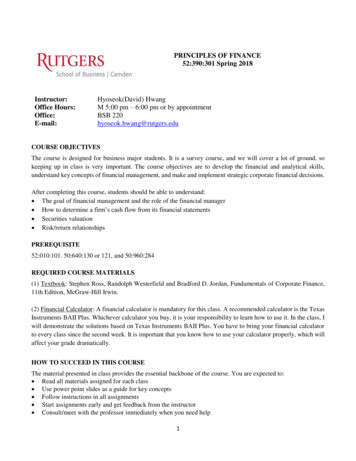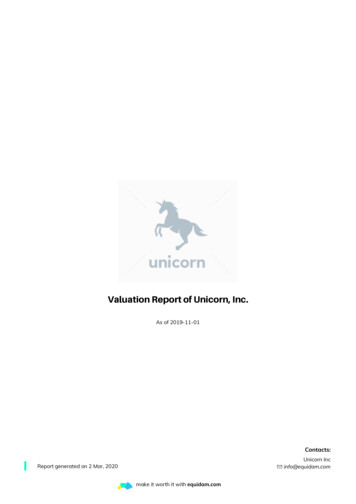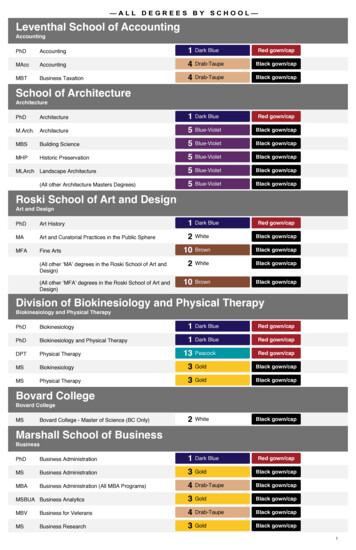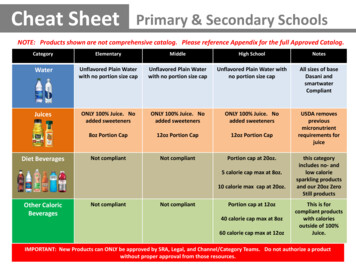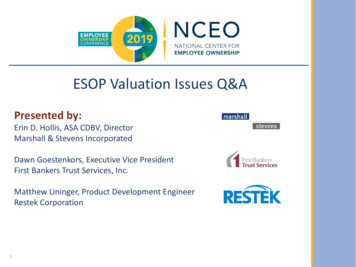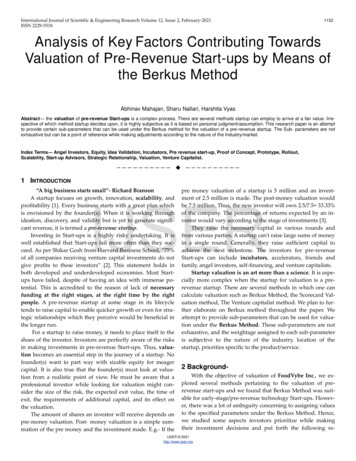
Transcription
March 20, 2021Valuation, Cap Tables, Terms Sheetsand Other Legal and FinancialConsiderationsK r i s t i n F ox Va n ta g e Po i n t A d v i s o rsPa t r i c k A n d i n g D L A P i p e rTheSDAngels.comSDAngelConfSDAC
Vantage Point AdvisorsVantage Point Advisors is a leading provider of valuation services for taxreporting and compliance, financial reporting, transaction advisory, fairnessand solvency opinions, litigation support, and other business advisoryservices, with offices in San Diego, Los Angeles, Portland, Seattle, New Yorkand Dallas-Fort Worth.Kristin FoxVantage Point AdvisorsDirector of Business Development11455 El Camino Real, Suite 450San Diego, CA 92130kfox@vpadvisors.comDirect 773.251.5731TheSDAngels.comSDAngelConfSDAC
DLA PiperDLA Piper is a global law firm with lawyers located in more than 40 countriesthroughout the Americas, Europe, the Middle East, Africa and Asia Pacific,positioning us to help clients with their legal needs around the world.Patrick AndingDLA PiperPartner4365 Executive Drive #1100San Diego, CA 92121patrick.anding@dlapiper.comDirect 415.603.8150TheSDAngels.comSDAngelConfSDAC
AGENDAWhat we hope to accomplish today: Review the principal types of seed financing Debt, Equity, Alternative Key Terms Benefits / Risks Explain the basics of valuation and considerations that should be topof mind for early stage founders during negotiations Provide an understanding as to why valuation is important inprotecting founders’ ownershipTheSDAngels.comSDAngelConfSDAC
Poling QuestionAre you an entrepreneur or an investor? Entrepreneur InvestorIf an investor, how many investments do you make per year? 1-2 3-5 5 If a founder, what category do you fall into from a fund-raising stageperspective: Pre-Seed Seed Series ATheSDAngels.comSDAngelConfSDAC
Principal Types of Seed Financing Cash contributions by foundersConvertible debt / bridge financingSAFEs (Simple Agreement for Future Equity)Preferred stock equity financing (Series Seed)TheSDAngels.comSDAngelConfSDAC
Founder Cash Contributions Initial fund raising from 3rd parties can take 6-12 months. Companies have expenses prior to 3rd party investment: Incorporation costsSoftware development / prototyping / wireframesLicense fees (software, patents, trademarks)Domain names / websites Travel expensesAccounting expenses / tax filingLegal feesOffice spaceConsultants / employees / service providers Founders often provide their companies with initial workingcapital for startup expenses and early developmentexpenses.TheSDAngels.comSDAngelConfSDAC
Founder Cash ContributionsFour ways to structure a cash contribution: Contribution to capital Upside increased cost basis in their common stock; cheap & easy.Downside founders don’t get their money back. Upside get more shares of common (but they have so many already!).Downside sets value of common stock; tax implications for other founders;increases the exercise price used for option grants (409A). Purchase common stock Invest in SAFEs, convertible debt or preferred equity. Upside get additional company securities with investor terms.Downside legal fees; complexity of documentation; investors may not like theterms if founders set terms; may need to wait for 3rd investors beforecontributing cash. Founder loan (non-convertible promissory note) [My Preference] Upside No 409A issues; simple & cheap, founders can sometimes get repaidby company (or convert in next round on investor terms), most flexible.Downside Liability on balance sheet, interest accrual.TheSDAngels.comSDAngelConfSDAC
Founder Cash Contributions Founder Loan Short Form Promissory Note Non-convertible note.Simple interest (don’t forget AFR).Maturity earlier of 3 years or time of first financing.Can be set up to accommodate multiple loans.TheSDAngels.comSDAngelConfSDAC
Seed Money / How Much? “How much should I Raise?” This is business not legal, but startups need our help with this. Thisis an opportunity to win clients on the basis of business experienceand guidance. Answer should be driven by: Near-term capital needs based on development roadmap & businessLong-term fund raising plan based on valuation inflection pointsRaise to and through next valuation milestonesTypical funding raising cycle from first pitch to close can be 6-12months What does the founder need to show the next round of investors(data, product market fit, validation, patents, prototype)? What do you want in the next pitch deck? Build towards that!TheSDAngels.comSDAngelConfSDAC
Convertible Notes / SAFEs Convertible debt aka convertible promissory notes, bridge notes, bridge financing,converts, convertibles. Simple Agreement for Future Equity aka SAFEs, Safes, Safe Notes (though not really “note”). Both solve the early stage valuation problem Early stage companies hard (maybe, impossible) to value (norevenue, no assets, etc.). How do you negotiate with investors? If priced, would be so low investors would own the company. Companies want to raise money to execute plan to reach valueinflection points, then value company in priced round. Like prepaying for stock in the equity round.TheSDAngels.comSDAngelConfSDAC
What Is A Convertible Note?A debt instrument with, among other features: Automatic conversion . . . . . of principal and interest . . . . . into capital stock . . . . . typically at a discount . . . . . in a financing in which a minimum threshold is raised(“Qualified Financing”) Ability to default; creditor status.TheSDAngels.comSDAngelConfSDAC
Purpose of Note/SAFE Offerings Unlike traditional debt, the expectation of the Note investorand the issuer is not that the investor will receive a returnequal to principal plus interest, but instead . . . Expectation is that the investor will become an equity holderwhen Qualified Financing achieved. SAFEs have a similar purpose as Notes, but eliminate conceptof ability to foreclose on assets, maturity date and accruedinterest.TheSDAngels.comSDAngelConfSDAC
Perceived Benefits for the Issuer Faster and cheaper to close then PreferredStock (fewer documents and terms tonegotiate, no charter amendment). Able to avoid pricing the round. Q: how does that impact FMV of common? SAFEs, as compared to Notes, have additionalbenefit for issuers of eliminating debt features. Enables ability to customize pricing and otherdeal terms for particular investors.TheSDAngels.comSDAngelConfSDAC
Perceived Benefits for the Investors Faster and cheaper! Important to rememberthat the investors money is paying for the bothissuer and investor transaction expenses. Somore cash for the company. Less negotiating / friction with founders. Some investors (particular angels) appreciatethe debt concept and priority in liquidation. For more most startups, this doesn’t matter asmost have little/no liquidation value.SAFES mirror the same priorities by contract,but some investors are still suspicious.TheSDAngels.comSDAngelConfSDAC
Later Stage Convertible Debt / SAFEs Standard for early stage, pre Series Seed/A. But also used in later stage–Post-Series A (often PostSeries B or C). Bridge the gap between equity financings or beforea sale. Typically, later stage non-equity financing are debtand not SAFEs, but that has been evolving.TheSDAngels.comSDAngelConfSDAC
Transaction Documents Term Sheet Summarize the key business terms of the financing. Not as common in SAFE financings. Note Purchase Agreement Not used in SAFE financing, but used in most debt financing bycustom, though not all. Sets the amount of notes that can be sold and establishes thetimeframe for sale of notes (multiple / rolling closes). Company and investor representations. Sometimes additional commercial terms or investors rights. Form Convertible Notes / SAFE The security and/or evidence of indebtedness. Contains principal, interest rate, terms of the repayment &conversion, events of default and other core terms.TheSDAngels.comSDAngelConfSDAC
Transaction Documents Warrants Rare for seed capital investments. More common in later stage investments. Security Agreement Rare for startup seed investments No assets to provided security. Subordination Agreement Rare in early stage investments, unless there is already outstandingdebt, such as bank line. Board and Stock Consents Always needs board consent. Sometimes need stockholders consents (waiver protective provision ornegative covenants; interested party disclosure, disinterested 3rd pattyconsent). Other 3rd party consents (other lenders)?TheSDAngels.comSDAngelConfSDAC
Key Terms Size of offering Period of additional closings. Multiple/rolling closes. Maturity Date. For Notes (but not SAFEs): payable upon demand after maturity(typically, 1-3 years). Only pre-payable with holder consent Interest (but not SAFEs). 4-8% Automatic conversion trigger. Size of equity raise that triggers a conversion (i.e. what qualifies as a“qualified financing”). YC SAFES no threshold, just sale of preferredstock in priced round. Typically, set to target for first equity round. 1M- 3M Should be more than the bridge round.TheSDAngels.comSDAngelConfSDAC
Key Terms Conversion price Discount off priced round (approx. 10-25%), Price based on valuation cap. Lesser or discount of valuation cap. (Market) Optional conversion on maturity. Into common stock or preferred at agreement upon price. Never allowFMW conversion price! Event of default (but not SAFEs). Can include CoC to ensure no overhang on exit. Amendment/voting thresholds. Holders of majority of principal; sometimes lead has block. Importantfor debt as extending the maturity date is common.TheSDAngels.comSDAngelConfSDAC
Key Terms Conversion price Discount off priced round (approx. 10-25%), Price based on valuation cap. Lesser or discount of valuation cap. (Market) Optional conversion on maturity. Into common stock or preferred at agreement upon price. Never allowFMW conversion price! Event of default (but not SAFEs). Can include CoC to ensure no overhang on exit. Amendment/voting thresholds. Holders of majority of principal; sometimes lead has block. Importantfor debt as extending the maturity date is common.TheSDAngels.comSDAngelConfSDAC
Key Terms Definition “Fully-Diluted Capitalization” for calculating conversionprice. Does it include full option pool, only issued options, otherconvertible notes or Safes, warrants issued with other debt. Newest yCombinator used “Post-Money” calculation instead ofpre-money calculation. Treatment in change of control. For Notes: if acquired prior to conversion, repayment withpremium (typically, principal interest premium of 50% to200%). For SAFEs: if acquired or IPO prior to conversion, investor canelect either repayment of investment without premium orconvert at the “Liquidity Price” (treated as if converted atvaluation cap).TheSDAngels.comSDAngelConfSDAC
Key Terms Converts into Preferred Stock. Liquidation preference based on new investor per share purchase. Conversion price is discounted, so the note/SAFEs are paying less thanthe liquidation preference. Example Series Seed share price of 1.00 20% discount means notes/SAFEs paying 0.80 If converting 800,000 of Notes/SAFEs then 1M preference. Difference in conversion price to liquidation preference can be verymeaningful when using valuation caps. SAFEs solve for this by creating “SAFE Preferred” where conversionprice and liquidation preference are the same.TheSDAngels.comSDAngelConfSDAC
Additional Investor Asks inSAFE/Note Financings Additional rights. Less common in Note and SAFE financing withinstitutional investors; but some ask. Participation rights. Most favored nations rights. Security interest in assets; blanket subordination by futurelenders or creditors. Major investor approval of amendments. Negative Covenants. Cover legal expenses for review of legal documents uponconversion. Board observer (or board seat). Information rights.TheSDAngels.comSDAngelConfSDAC
Investor ConsiderationsPros: Simpler mechanism than Preferred Stock to deploy small amountsof capital Valuation cap and discount provide built-in anti-dilution and priceprotection until next priced round. If there have been prior priced rounds, convertible note providesstructural liquidation preference until converted.TheSDAngels.comSDAngelConfSDAC
Investor ConsiderationsCons: Rights, protections and diligence often lighter than priced round. Typically no board seat and little or no mechanisms formanagement oversight and control. Since not a stockholder, does board owe investor fiduciary duty?TheSDAngels.comSDAngelConfSDAC
What’s Market (According to Data) Interest 87% of deals less than 8% Maturity 78% of deals greater than 12 months Discount 60% of deals have a 20% discount 20% of deals have a discount above 20% 20% of deals have a discount below 20% Valuation Cap 69% of deals have valuation cap Mean in 2019 for valuation cap was 9M Mean Q1 of 2020 for valuation cap was 4M Warrants Less than 2%Source: Wilson Sonsini Q1 2020 Entrepreneurs Report for Pre-Seed convertible debt roundsTheSDAngels.comSDAngelConfSDAC
What’s Market (My take) Interest 4-8% simple interest, typically 6% Maturity 2 years Discount 20% Valuation Cap 4M to 10M Depending on sector and target Seed/Series A valuation Conversion Trigger 2MChange of Control Principal interest premium equal to 100% of principalIf you offer terms in this range, you’ll be in the market.TheSDAngels.comSDAngelConfSDAC
Poling QuestionAre you considering utilizing convertible debt or a SAFE toraise a seed round of financing?If so, what discount is market? 5% 10% 20% 30%TheSDAngels.comSDAngelConfSDAC
Venture Debt: truly non-dilutive?Venture debt providers coin their financing options as “non-dilutive capital”. But is itreally? What to be aware of Venture term loans typically have warrant coverage. This means you are beingoffered a typical interest bearing loan but also giving the lender essentially“options” to own an equity stake in the future, above a fixed strike price. Convertible notes often seem attractive but discount factors at conversion canoverly dilute founder’s ownership. Example to follow. High yield debt with no equity component can still trigger dilution. How? Above market interest rates mean a higher burn rate and less cash flowretained. This equates to a shorter cash runway and the need tofundraise that next round earlier (triggering earlier than necessarydilution).TheSDAngels.comSDAngelConfSDAC
Raising convertible debt – whythe discount mattersMost “first-in” debt financiers want a discount on their future conversionto equity and that discount matters Assume 1,000,000 convertible promissory note at 8% interest Next qualified financing (“NQF”) / conversion is 2 years from issuance date Interest accrued would be 160,000 Principal and interest would be 1,160,000 at NQF 10,000,000 shares of common stock are outstanding in addition to theconvertible note. The next qualified financing issue price is expected to be 1.00.TheSDAngels.comSDAngelConfSDAC
Raising convertible debt – whythe discount matters Ownership given up with no discount 10.4% Converts into 1,160,000 shares 1,160,000 / ( 1.00 * (1 – 0%)) 1,160,000 Ownership given up with conversion at 20% discount 12.7% Converts into 1,450,000 shares 1,160,000 / ( 1.00 * ( 1 – 20%)) 1,450,000 Ownership given up with conversion at 50% discount 18.8% Converts into 2,320,000 shares 1,160,000 / ( 1.00 * ( 1 – 50%)) 2,320,000TheSDAngels.comSDAngelConfSDAC
Series Seed Equity Financings Preferred vs Common Stock Common stock is generally used for compensatory purposes (i.e., as a form ofpayment to employees, board members, consultants, advisors and otherservice providers) and issued to founders at incorporation. Preferred stock is generally used for investment purposes and has many morerights, preferences and powers than common stock. Common stock is typically “priced” at a lower price than preferred stock (i.e.,for option granting purposes). Preferred stock issued through the creation of multiple “series”. Common stock typically a single series/class, though occasionally companiesmy implement multiple classes of common stock to provided for differentvoting rights or governance controls. Preferred stock is typically convertible into common stock.TheSDAngels.comSDAngelConfSDAC
Preferred StockAuthority in Delaware General Corporate Law§ 151 Classes and series of stock; redemption; rights(a) Every corporation may issue 1 or more classes of stock or 1 ormore series of stock within any class thereof, any or all of whichclasses may be of stock with par value or stock without par value andwhich classes or series may have such voting powers, full or limited,or no voting powers, and such designations, preferences and relative,participating, optional or other special rights, and qualifications,limitations or restrictions thereof, as shall be stated and expressed inthe certificate of incorporation or of any amendment thereto, or in theresolution or resolutions providing for the issue of such stock adoptedby the board of directors pursuant to authority expressly vested in it bythe provisions of its certificate of incorporation TheSDAngels.comSDAngelConfSDAC
Overview of Preferred FinancingStock TermsEconomic Terms Valuation Anti-dilutionprotection Investment amountUse of proceedsLiquidationpreferenceConversion featuresDividendsOther Deal TermsControl / Governance Protective provisionsBoard compositionManagement rightsObserver rightsInformation rightsPost-closing covenants(D&O insurance, mandatoryboard meetings)Redemption rightsRegistration rightsPreemptive lConfLegal optionMultiple closing / single closing /tranches & milestones Reincorporation (DE, convertfrom LLC) Exclusivity / no-shop period Due diligence Founder/employee vesting Employment agreements, noncompetes, non-solicits Legal expenses Confidentiality Regulatory matters Commercial agreements IP mattersSDAC35
Series Seed Financing TermsSeries Seed Preferred Stock “Series Seed” equity rounds begin to in Silicon Valley in late 2000s Technology advances allowed for companies to launch with lessmoney than typically needed in “Series A” financing ( 1.5M vs 4M). Typical Series A terms too complicated for a small financing andsome investors really do want equity (rather than convertibles). Series “Seed” was intended to reduce transaction costs for equityrounds by limiting the terms/rights and documentation. Also, allowed for higher valuations at Series A and beyond, whichfounders and VC funds liked optically.TheSDAngels.comSDAngelConfSDAC
Seed Series EquityFinancing Terms Following the trend, attorneys from Fenwick & West released form SeriesSeed Documents that striped away many standard Series A terms. Thedocuments removed : Preferential dividendsPrice-based antidilution protectionRedemption rightsClosing conditions or closing certificatesLegal opinionMany reps & warrantiesRegistration rightsManagement covenantsCo-sale rightsSee: onfSDAC
Seed Series EquityFinancing Terms So what remained were 30 pages, rather than 100 pages of documents.Economic TermsControl / Governance ValuationInvestment amountLiquidation preferencePreemptive/participationrightsROFR over founder’s stocksalesTheSDAngels.comSDAngelConfProtective provisionsBoard compositionObserver rightsInformation rightsNEW: Most-favored nationstatus with rights the investorsin the next round of financinggetSDAC
Series Seed Equity Financing Terms Adoption of “Series Seed” help contribute to increasing valuations for Series A andbeyond. Founders liked this because a higher valuation Series A had the optics of being a moresuccessful, in-demand, or “hot” startup. Companies eventually even began having “Series Pre-Seed” financings. Today, a tech company may have a SAFE/debt financing, a Pre-Seed, Series Seed, andSeries Seed-1 before raising a Series A. As valuations increased through out the 2010’s, Series Seed financing began looking alot more like a Series A. Series Seed financing today have many or most of the standard Series A terms(antidilution, preferential dividends, registration rights, management rights, etc.). Today, many investors use “Series Seed” and “Series A” to refer to the same set ofrights, preferences, and powers.TheSDAngels.comSDAngelConfSDAC
Poling QuestionDo you know the range of multiples companies in yourindustry are trading at?Do you have a financial forecast for your startup? Yes No If you answered yes, is your forecast: High Level DetailedTheSDAngels.comSDAngelConfSDAC
Equity Valuation Valuation: how much the company is “worth” No matter how a Company will be financed, valuation will play a major role in the terms Negotiated terms between the company and the investors using many different data points Simplified - All business valuations hinge upon 3 main factors: 1)Growth2)Cash flow generation (margin & earnings)3)RiskInvestors pay for future expected cash flows (earnings). Underlying assets (systems, products/services, or technologies, etc.) produce that expected cash flow.The rate of return captures the risk of achieving those cash flows.Most SDAC affiliated companies currently are: High risk; Low to no margin/earnings; But with hyper growth potential.TheSDAngels.comSDAngelConfSDAC
Basics of ValuationAll companies, even early stage start-ups, can be valued using one of 3 main valuationapproaches:Income ApproachCapitalization of EarningsDiscounted Cash FlowMarket ApproachGuideline Public CompanyTransaction AnalysisCost ApproachReplacement CostAnalysisEnterprise ValueBalance gelConfSDAC
Basics of Valuation Income Approach – Discounted Cash Flow Method Where the company’s future performance discounted at an applicable rateof return indicates its worth today. Should include future efforts of built-out management team and thebenefits of the capital raise. Discount rate selection is big. Using a public company cost of capital(single digits or low teens) will over inflate your valuation and makeyou look unsophisticated to some investors. Using a typical venture-backed rate of return (20%-40%) is appropriateand will make you look like you know what you’re doing!TheSDAngels.comSDAngelConfSDAC
Basics of Valuation Market Approach – Guideline Public Company Method or GuidelineTransaction Method Pricing pre-money value off of multiples of future, projectedmetrics. Examples: Pre-money valuation based off 2x 3-year forwardrevenue forecast or 8x 3-year forward EBITDA forecast. Cost Approach – Replacement Cost Method Method is applicable for tech companies where developed IP isthe main asset of the company. Aggregation of the amount spent to date (including sweatequity) multiplied by an expected yield.TheSDAngels.comSDAngelConfSDAC
Equity Valuation Valuation is expressed in terms of pre-money and post-money. Pre-Money is the valuation of the company before VC’s invest The Number of Shares Outstanding On a Fully Diluted BasisMultiplied by the Share Price The Proposed Pre-MoneyValuation Post-Money is the valuation after investment Pre-money VC Investment Post-money How much of the company are the current stockholders willing to give up.TheSDAngels.comSDAngelConfSDAC
Valuation VS. % Equity Ownership Valuation vs. percentage of equity ownership For early stage company, valuation is very subjective and based onforward looking opportunity. During negotiations, oftentimes valuationwill end up being a proxy for ownership percentage. Post-money ownership percentage for investors is: Investment amount divided by post-money valuation Post-money valuation pre-money investment amountTheSDAngels.comSDAngelConfSDAC
Valuation VS. % Equity OwnershipExample:“We’re willing to put 3M in at a 6M pre-money valuation”“We need to have 33.33% of the company if we are going to invest 3M”Post-money 6M (pre) 3M (new cash) 9MInvestors Ownership 3M / 9 33.33%Founders ownership 100% - 33.33% 66.66%TheSDAngels.comSDAngelConfSDAC
Valuation: why it’s important to startupsA Simple Example – Most startups use the basic formula of how much ownershipthey are willing to initially give up and how much they need to fundraise. Asfollows: Seeking to raise 1 million in Series A Current shares outstanding are 100 I’m only willing to give up 20% ownership Post-Money 1 million 20% 5 millionNow 25 Series A shares out of 125 total shares Pre-Money 5 million post-money less 1 million invested 4 millionTheSDAngels.comSDAngelConfSDAC
Valuation: why it’s important to startupsWhat if a full valuation was performed and the Co. determined its pre-money valuewas actually 7 million? Post-Money 7M Pre- 1M raised 8M 1M/ 8M 12.5% ownership given upThe owners have managed to keep 7.5% more ownership than at the 4M Pre- . We’vethwarted off unnecessary dilution!Valuation equally important for debt financing where lenders focus on solvencymetrics. Loan to enterprise value - 1M/ 4M 25% Loan to enterprise value - 1M/ 7M 14%TheSDAngels.comSDAngelConfSDAC
Summing it UpBut remember ultimately, your Co. pre- valuation is whatmarket is willing to bear. theA prominent VC once said that funding a company’s first round comesdown to largely 2 things:1) Do I TRUST this founder?2) Did this pitch BORE or CONFUSE me?TheSDAngels.comSDAngelConfSDAC
FEATURES TO BE AWARE OF(INVESTOR FAVORABLE)Financing FeatureDebt – warrant coverageDebt – deep discount conversion %’s on convertible notesDebt – above market interest ratesEquity - participationEquity – cumulative dividendsEquity - 1:1 conversionEquity - 1x LP51
Poling QuestionFounders: Are you raising capital in the next 6 – 12 months?If so, what amount are you looking to raise? 100K - 250K 250K - 2M 2M TheSDAngels.comSDAngelConfSDAC
First Republic BankInnovators ToolkitOpen a New 250K Business Checking Account 409A Valuation – Vantage Point Advisors, Inc. 2020 Bonus Cash Other ngels.comSDAngelConfSDAC
THANK YOUTheSDAngels.comSDAngelConfSDAC
Price based on valuation cap. Lesser or discount of valuation cap. (Market) Optional conversion on maturity. Into common stock or preferred at agreement upon price. Never allow FMW conversion price! Event of default (but not SAFEs). Can include CoC to ensure no overhang on exit. Amendment/voting thresholds.
